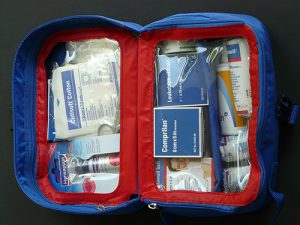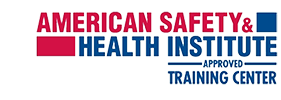First-aid kits are the kind of thing that we don’t think about until we need to use it, although we rely on them when someone is hurt. Even though first-aid kit maintenance isn’t at the forefront of most people’s mind, it is important to check your kit regularly and restock it as needed. Any emergency can require the use of First Aid and you do not want to be missing kit essentials.
But what should be in your first-aid kit? Should you have more than one? Where should you keep your kit(s)?
 Let’s start with where you should keep your first-aid kit and how many you should have. Ideally, you’ll have a few kits.
Let’s start with where you should keep your first-aid kit and how many you should have. Ideally, you’ll have a few kits.
It’s a good idea to keep one at home, in your car, in your child’s diaper bag, and with any outdoor gear (camping, hiking, etc) you use regularly. You should keep your kits where they are easily accessible so anyone who might administer first-aid will be able to reach it quickly. You don’t want to waste time looking for it in an emergency!
Now that you know where to keep it, do you know what should be in your first-aid kit? Whether it’s a hiking first-aid kit, one that stays in your car, or one you keep at home, there are a few things that should be in every basic first-aid kit.
What Should Be in a First-Aid Kit?
You can purchase ready-made kits from a drugstore or assemble your own.
While there are a lot of items that could go into a first-aid kit, a well-stocked one should have the following basic items:
- Bandages in assorted sizes
- Butterfly bandages for cuts
- Medical tape
- Elastic bandages
- Sterile gauze pads and/or gauze roll
- Cotton swabs and cotton balls
- Antibiotic ointment
- Antiseptic spray or towelettes
- Aspirin
- Sterile saline solution
- Disposable non-latex gloves
- Tweezers
- Scissors
- An epinephrine pen if anyone if your family has severe allergies
- Any medications your family members may need in an emergency
- Emergency contact information and phone numbers for your family doctor/pediatrician, local emergency services, and the poison help line (1-800-222-1222 in the United States)
Other useful items you may include in your basic first-aid kit are:
- Over-the-counter pain relievers like ibuprofen
- A thermometer
- Hydrocortisone cream for insect bites or mild cases of poison ivy or poison oak
- Aloe vera gel for burns
- Anti-nausea medication for carsickness (travel first-aid kits only)
- Antihistamines for allergic reactions and poison ivy/oak
- Instant cold packs
- Hand sanitizer
If you are a parent or caregiver to small children, add the following items to your basic first-aid kit:
- Children’s pain reliever along with dosage instructions and a cup or syringe to dispense medicine
- A bulb suction device
- Bandages in fun colors or patterns (optional but they can go a long way in making your little one feel better!)
In addition to the essentials, a camping or hiking first-aid kit should include:
- A water bottle to clean wounds
- Small, waterproof flashlight or headlamp and extra batteries
- Waterproof matches
- Emergency “space” blanket
- A solar charger for your cell phone
- Hydrocortisone cream
- Antihistamines for contact with poison ivy/oak
First-Aid Kit Maintenance
In addition to keeping a well-stocked first-aid kit, it’s important to go through your kit periodically to take stock of what’s in it, replenish any items you’re out of or low on, and dispose of any expired medications or outdated items. This will prevent you from discovering you’re out of something when you need it most.
Add CPR To Your First-Aid Care
Your first-aid kit is a great line of defense against minor injuries and emergencies but with Basic Life Support CPR training and Pediatric First Aid Training, you’ll be equipped to handle more serious incidents. Our team at CPR Educators, Inc teaches basic CPR and many other life-saving tips online or in-person. To register for a class, call us now at (919) 639-4848 or register online.



